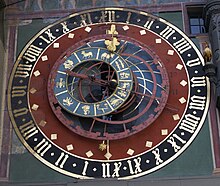Temporal hour
Temporal hours or temperoral hours , also biblical or Jewish hours as well as ancient or Roman hours , Latin horae temporales , are the designations for the same periods that do not remain the same throughout the year, into which on the one hand the light day and on the other hand the night are divided. From the late Middle Ages, their everyday use was replaced by the equinox hours of equal length that are common today .
The first temporal hour begins at sunrise or sunset . If bright day and night are divided into twelve temporal hours each, then noon and midnight are each the beginning of the seventh hour.
A clock that shows the temporal hours is called a temporal clock .
Astronomical basics
The astronomical term arc of the sun corresponds to the concept of daylight . With the exception of the equator , the length of the clear day depends on the geographical latitude and the season . At 49 ° north / south. Width (e.g. in Karlsruhe ) it fluctuates between 16 equinox hours in summer and 8 equinox hours in winter. From 66.5 ° north / south. Width the sun no longer sets (the horizon ) every day in summer and no longer rises every day in winter - the 'day' in the sense of the term no longer exists. For more information on this, see Aufgang (astronomy) .
Due to the continuous change in the lengths of the clear day and night in the course of the year, the lengths of the day division, i.e. the temporal day hours and the temporal night hours, also change over the year.
The temporal hours of day and night are only the same length at the beginning of spring and autumn ( equinox , equinoxes ). In summer the day hours are longer, in winter the night hours.
history
Temporal hours were common in many cultures. A division of the day and night into twelve hours is first documented in ancient Egypt . A similar subdivision of light day and night was made later in the Mediterranean region from around classical Greek antiquity into twelve temporal hours each ( Greek ὥραι καιρικαί , horai kairikai ).
In our culture they were adopted from the Roman era and were common in the European Middle Ages and beyond. They were particularly important in the established daily routine of the monastic orders. This division of time made it possible to do the work of the day - such as eating, praying or working - always at the same (temporal) hour, regardless of how long the clear day was.
This time calculation is also used by the Jewish religious law ( Halacha ), hence the Jewish or biblical division of hours .
With the increasing popularity and importance of mechanical clocks , the temporal hours were replaced by the equinox, which are the same length throughout the day. The latter are only used today when specifying the time .
Temporal clocks
The sundial with nodus as a pointer was used almost exclusively for the display of temporal hours . The different height of the sun over the course of the year served as a parameter on which the different length of the temporal hours in the course of the year depends.
Many astronomical clocks that were created during the transition to the equinox of the same length also show the temporal hours in addition to the new hours of the same length. Where temporal hours continued to be used for a long time (especially in monasteries), the new, evenly running mechanical clock accelerating the transition to the hours of equal length was permanently set faster / slower, with two different settings for day and night or a clock for day and night were necessary. For the latter, for example , the speed of the scales was changed in 26 steps (52 weeks ÷ 2). In the weeks of the equinox , both clocks could be operated with the middle weight position on the scales. The two displays of the astronomical clocks are identical at this time.
See also
- Babylonian hours (hours from sunrise)
- Italian hours (hours from sunset)
- Seasonal hours
- Subjective day , chronobiology
- Day (ancient egypt)
literature
- Karlheinz Deußer: Temporal clocks: The search for mechanical clocks that run with temporal hours. In: Annual journal of the German Chronometry Society. Volume 51, 2012, pp. 143-160.
- Jürgen Osing: Hieratic papyri from Tebtunis I (Carsten Niebuhr Institute of Ancient Eastern Studies Copenhagen) . Museum Tusculanum Press, Copenhagen 1998, ISBN 8-7728-9280-3 .
- Rudolf Wendorff: Time and Culture. History of time consciousness in Europe . Westdeutscher Vlg, Wiesbaden 1980, ISBN 3-531-11515-4 .
Web links
Remarks
- ^ Karlheinz Deußer: Temporal clocks: The search for mechanical clocks that ran with temporal hours. 2012.

